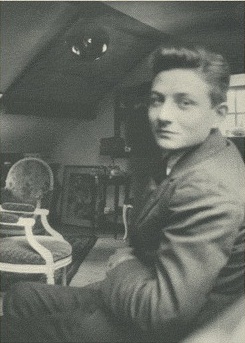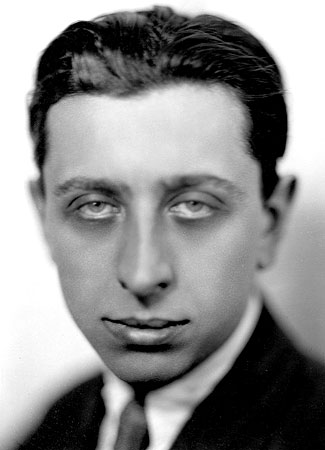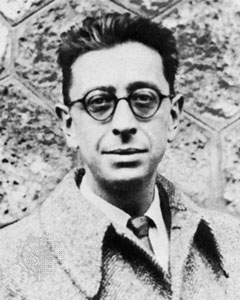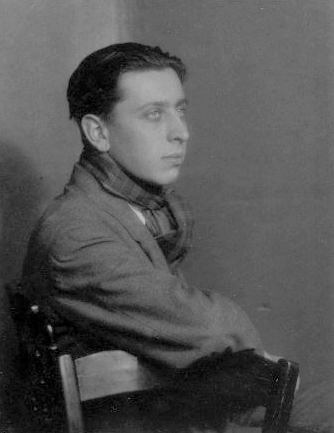<Back to Index>
- Poet Jacques Baron, 1905
- Poet Robert Desnos, 1900
PAGE SPONSOR

Jacques Baron (1905 – 1986) was a French surrealist poet whose first collection of poems was published in Aventure in 1921. Although he was initially involved with the Dada movement, he became a founding member of the Surrealist movement following his meeting with André Breton in 1921, and contributed to La Révolution surréaliste. In 1927, like many of his contemporaries, Baron joined the Cercle Communiste Démocratique. Although fascinated by dream - like states of the nomadic unconscious and other imaginary worlds of the “marvelous”, a dispute with Breton in 1929 got him expelled from the movement, and prompted him to contribute to Un Cadavre, an anti - Breton pamphlet. After the break with Surrealism, Baron became associated with Georges Bataille and Documents, in which he published a short essay on "Crustaceans for the Critical Dictionary" (1929, issue 6), an article on the sculptor Jacques Lipchitz (1930, issue 1), and a poem dedicated to Picasso, "Flames" (1930, issue 3). He later collaborated on a number of reviews such as Le Voyage en Grèce, La Critique Sociale and Minotaure. Baron also wrote a novel, Charbon de mer (1935), a mémoire, L’An 1 du Surréalisme (1969), and a collection of poems, L’Allure poétique (1973).



Robert Desnos (4 July 1900 – 8 June 1945), was a French surrealist poet who played a key role in the Surrealist movement of his day.
Robert Desnos was born in Paris on 4 July 1900, the son of a licensed dealer in game and poultry at the Halles market. Desnos attended commercial college, and started work as a clerk. After that he worked as a literary columnist for the newspaper Paris - Soir.
The first poems by Desnos to appear in print were published in 1917 in La Tribune des Jeunes (Platform for Youth) and in 1919 in the avant garde review, Le Trait d’union (HYPHEN), and also the same year in the Dadaist magazine Littérature. In 1922 he published his first book, a collection of surrealistic aphorisms, with the title Rrose Sélavy (based upon the name (pseudonym) of the popular French artist Marcel Duchamp).
In 1919, he met the poet Benjamin Péret who introduced him to the Paris Dada group and André Breton, with whom he soon became friends. While working as a literary columnist for Paris - Soir, Desnos was an active member of the Surrealist group and developed a particular talent for "automatic writing". He, together with writers such as Louis Aragon and Paul Éluard, would form the literary vanguard of surrealism. André Breton included two photographs of Desnos sleeping in his surrealist novel Nadja. Although he was praised by Breton in his 1924 Manifeste du Surréalisme for being the movement's "prophet", Desnos disagreed with Surrealism's involvement in communist politics, which caused a rift between him and Breton. Desnos continued work as a columnist.
In 1926 he composed The Night of Loveless Nights, a lyric poem dealing with solitude curiously written in classic quatrains, which makes it more like Baudelaire than Breton. Desnos fell in love with Yvonne George, a singer whose obsessed fans made his love impossible. He wrote several poems for her, as well as the erotic surrealist novel La liberté ou l'amour! (1927). Critic Ray Keenoy describes La liberté ou l'amour! as "literary and lyrical in its outpourings of sexual delirium".
By 1929, Breton definitively condemned Desnos, who in turn joined Georges Bataille and Documents, as one of the authors to sign Un Cadavre (A cadaver) attacking "le boeuf Breton" (the ox Breton). He wrote articles on "Modern Imagery", "Avant - garde Cinema" (1929, issue 7), "Pygmalion and the Sphinx" (1930, issue 1), and Sergei Eisenstein, the Soviet filmmaker, on his film titled The General Line (1930, issue 4).
His career in radio began in 1932 with a show dedicated to Fantomas. During that time, he became friends with Picasso, Hemingway, Artaud and John Dos Passos; published many critical reviews on jazz and cinema; and became increasingly involved in politics. He wrote for many periodicals, including Littérature, La Révolution surréaliste, and Variétés. Besides his numerous collections of poems, he published three novels, Deuil pour deuil (1924), La Liberté ou l’amour! (1927), and Le vin est tiré (1943); a play La Place De L'Etoile, (1928; revised 1944) and a film script, L'Etoile de mer (1928), which was directed by Man Ray that same year.
During World War II, Desnos was an active member of the French Résistance network Réseau AGIR, under the direction of Michel Hollard, often publishing under pseudonyms. For Réseau Agir, Desnos provided information collected during his job at the journal Aujourd'hui and made false identity papers and was arrested by the Gestapo on 22 February 1944.
He was first deported to the Nazi German concentration camps of Auschwitz in occupied Poland, then Buchenwald, Flossenburg in Germany and finally to Terezín (Theresienstadt) in occupied Czechoslovakia in 1945.
Susan Griffin relates a story that exemplifies Desnos' surrealist spirit:
| “ | One day Desnos
and others were taken away from their barracks. The prisoners rode on
the back of a flatbed truck; they knew the truck was going to the gas
chamber; no one spoke. Soon they arrived and the guards ordered them off
the truck. When they began to move toward the gas chamber, suddenly
Desnos jumped out of line and grabbed the hand of the woman in front of
him. He was animated and he began to read her palm. The forecast was
good: a long life, many grandchildren, abundant joy. A person nearby
offered his palm to Desnos. Here, too, Desnos foresaw a long life filled
with happiness and success. The other prisoners came to life, eagerly
thrusting their palms toward Desnos and, in each case, he foresaw long
and joyous lives.
The guards became visibly disoriented. Minutes before they were on a routine mission the outcome of which seemed inevitable, but now they became tentative in their movements. Desnos was so effective in creating a new reality that the guards were unable to go through with the executions. They ordered the prisoners back onto the truck and took them back to the barracks. Desnos never was executed. Through the power of imagination, he saved his own life and the lives of others. |
” |
Desnos died in "Malá pevnost", which was an inner part of Terezín used only for political prisoners, from typhoid, only weeks after the camp's liberation. He wrote poems during his imprisonment which were accidentally destroyed following his death.
He was married to Youki Desnos, formerly Lucie Badoud, nicknamed "Youki" ("snow") by her lover Tsuguharu Foujita before she left him for Desnos. Desnos wrote several poems about her. One of his most famous poems is "Letter to Youki", written after his arrest.
He is buried at the Montparnasse cemetery in Paris.
Desnos' poetry has been set to music by a number of composers, including Witold Lutosławski with Les Espaces du Sommeil (1975) and Chantefleurs et Chantefables (1991), Francis Poulenc (Dernier poème, 1956) and Henri Dutilleux with Le Temps l'Horloge (2007). Carolyn Forché has translated his poetry and names Desnos as a significant influence on her own work.
In 1974, at the urging of Robert Desnos' widow, Joan Miró published an “illustrated book” with Robert Desnos titled "Les pénalités de l'enfer ou les nouvelles Hébrides" (The Penalties of Hell or The New Hebrides), Maeght Editeur, Paris, 1974. It was a set of 25 lithographs, five in black, and the others in colors.
In 2006 the book was displayed in “Joan Miró, Illustrated Books” at the Vero Beach Museum of Art. One critic said it is “an especially powerful set, not only for the rich imagery but also for the story behind the book's creation. The lithographs are long, narrow verticals, and while they feature Miró's familiar shapes, there's an unusual emphasis on texture." The critic continued, “I was instantly attracted to these four prints, to an emotional lushness, that's in contrast with the cool surfaces of so much of Miró's work. Their poignancy is even greater, I think, when you read how they came to be. The artist met and became friends with Desnos, perhaps the most beloved and influential surrealist writer, in 1925, and before long, they made plans to collaborate on a livre d'artist. Those plans were put on hold because of the Spanish civil war and World War II. Desnos' bold criticism of the latter led to his imprisonment in Auschwitz, and he died at age 45 shortly after his release in 1945. Nearly three decades later, at the suggestion of Desnos' widow, Miró set out to illustrate the poet's manuscript. It was his first work in prose, which was written in Morocco in 1922 but remained unpublished until this posthumous collaboration.
A reading of "Relation d'un Reve" (Description of a Dream) recorded by Desnos for radio broadcast in 1938 can be heard on the audiobook CD Surrealism Reviewed, issued in 2002.